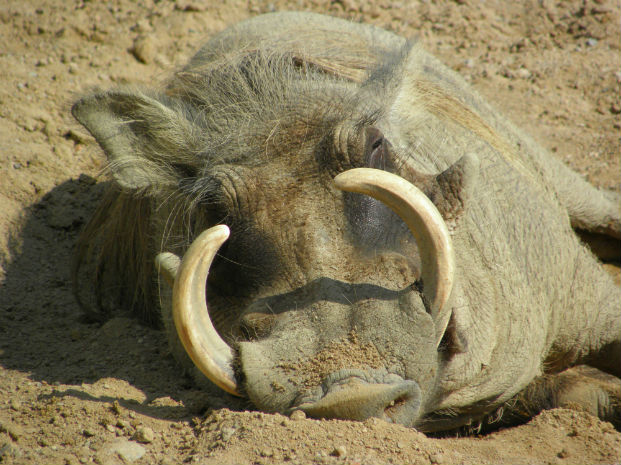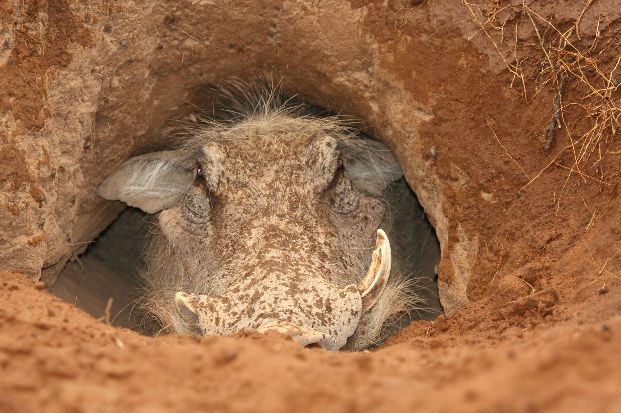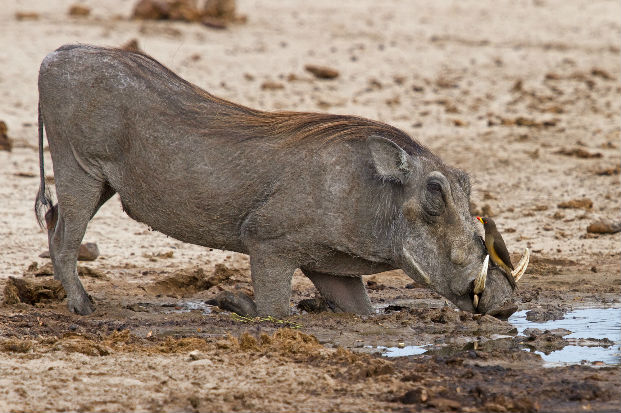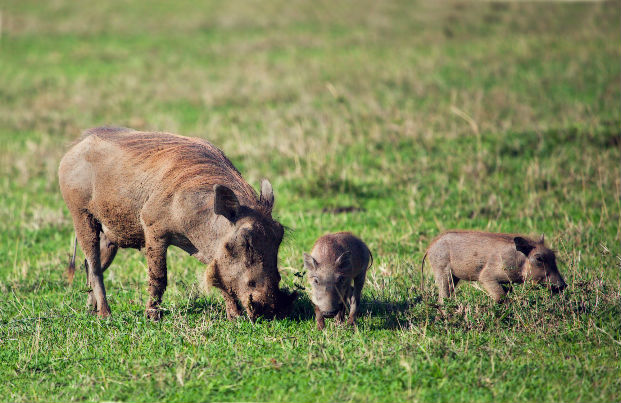
The warthog is a member of the pig family. Their preferred habitat is open grassland, savanna and woodland. It gets its name from a single pair of “warts” situated below its eyes. These lumps of thickened skin and bristle are used as a defence from an opponent’s tusks. Males have a second pair close to their tusks.
Warthogs live in a group called a sounder. This may number 16 but usually five or less. They have a varied diet, they will eat bones, soil and stones for their mineral content. They’ll also scavenge both the meat and stomach contents from a carcass.
Interesting facts about the warthog
1. Parental care
A female will forge a raised shelf in the burrow on which the piglets will sleep. This keeps them out of cold water which may run into the main chamber.
2. Piglet digestion
Piglets will eat their mother’s dung to colonise their guts with the bacteria that is needed for digestion.
3. Tusk mimicry
The jawline of a warthog is fringed with upward growing white bristles that mimic tusks in an effort to ward off predators. This is particularly useful for young warthogs which are otherwise defenceless.

4. Predator evasion
An adult will reverse into its burrow so its tusks can be used against anything that tries to enter the hole. When it’s time to leave it will do so at full speed to reduce the chance of being caught by a predator.

5. Nutritious diet
The warthog and the hippo are the only two herbivores that do not have to feed for at least twelve hours of the day. The warthog achieved this by eating highly nutritious roots and bulbs.
6. Tail chasing
Piglets are very playful animals, playing together and on their own. The latter may include a game of “whirling”, tail chasing.

7. Tusks
The outer tusks of a warthog, which are elongated canine teeth, can reach 60 cm and the lower set 13cm. Each time it opens and closes its mouth the upper and lower tusks rub against each other which keeps the lower set razor sharp.
8. Digging
The warthog will use the back of its nose for shovelling earth when digging. When doing so it can close its nostrils to stop them from filling with soil.

Frequently asked questions
- What is a warthog?
- What is the scientific name for a warthog?
- Are warthogs pigs?
- How much does a warthog weigh?
- How long do warthogs live?
- How many babies do warthogs have?
- Where do warthogs live?
- What do warthogs eat?
- What eats warthogs?
- Do warthogs have warts?
- How many tusks do warthogs have?
- What do you call a group of warthogs?
- Warthogs in popular fiction
- Vote for your favourite fact
What is a warthog?
The common warthog is a member of the pig family (Suidae) that lives in sub-Saharan Africa. They are named after the pair of warts situated below their eyes. Their preferred habitat is open grassland, savanna and woodland. There is one other species of warthog, the desert warthog (Phacochoerus aethiopicus).
What is the scientific name of a warthog?
The scientific name for a warthog is Phacochoerus africanus. The genus, Phacochoerus stems from two Greek words. The first is phakos which means a mole or wart and the second, khoiros meaning a pig. The specific name is simply a reflection of the continent Africa where it can be found.
Are warthogs pigs?
The warthog belongs to the pig family, Suidae. Animals within this family are commonly referred to as pigs, hogs and boars. In all there are 18 species within this family plus the domesticated pig which is a subspecies of the wild boar.
How much does a warthog weigh?
A warthog weighs between 50kg and 70kg. Their height at the shoulder is 55cm to 70cm.
How long do warthogs live?
A warthog can live up to 20 years old.
Howe many babies do warthogs have?
A warthog will have between 2 to 5 babies (piglets) after a gestation period of 5.5 months.
Where do warthogs live?
The common warthog lives in open grassland, savanna and woodland of sub-Saharan Africa. There is a second species, the desert warthog (Phacochoerus aethiopicus) that lives in Kenya and Somalia. The warthog will often take over used aardvark holes and use them to sleep in over night and for raising young.
What so warthogs eat?
They have a varied diet, they will eat bones, soil and stones for their mineral content. They’ll also scavenge both the meat and stomach contents from a carcass.
What eats warthogs?
There are a variety of animals that predate warthog. Predators include lion, leopard, hyena, crocodiles, cheetahs and even eagles such as the martial eagle.
Do warthogs have warts?
They have a single pair of “warts” situated below its eyes. These lumps of thickened skin and bristle are used as a defence from an opponent’s tusks. Males have a second pair close to their tusks.
How many tusks do warthogs have?
A warthog has four tusks (2 pairs). The outer tusks of a warthog, which are elongated canine teeth, can reach 60 cm and the lower set 13cm. Each time it opens and closes its mouth the upper and lower tusks rub against each other keeping the lower set razor sharp.
What is a group of warthogs called?
A group of warthogs is called a sounder which usually numbers 5 or less but can be as many as 16.
Warthogs in popular fiction
What type of animal were Pumbaa and Timon in the Lion King?
In the Lion King Pumbaa was a warthog and his buddy Timon was a meerkat. They were the unusual pair that took Simba in when he was forced to leave his pride after the death of his father. Timon and Pumbaa even had their own spin off TV series.
What was Pumbaa and Timon’s song in the Lion King?
In the Lion King, Pumbaa and Timon explain to Simba that a life can be very simple of you keep one thing in mind. Having no troubles. The warthog and meerkat sing Hakuna Matata.
Video length: 4 minutes 3 seconds. Video source: Dudu
Vote for the fact you find most fascinating
Piglets are very playful animals, playing together and on their own. The latter may include a game of “whirling”, tail chasing.
The outer tusks of a warthog, which are elongated canine teeth, can reach 60 cm and the lower set 13cm. Each time it opens and closes its mouth the upper and lower tusks rub against each other which keeps the lower set razor sharp.
The jawline of a warthog is fringed with upward growing white bristles that mimic tusks in an effort to ward off predators. This is particularly useful for young warthogs which are otherwise defenceless.
An adult warthog will reverse into its burrow so its tusks can be used against anything that tries to enter the hole. When it’s time to leave it will do so at full speed to reduce the chance of being caught by a predator.
The warthog will use the back of its nose for shovelling earth when digging. When doing so it can close its nostrils to stop them from filling with soil.
Piglets will eat their mother’s dung to colonise their guts with the bacteria that is needed for digestion.
A female warthog will forge a raised shelf in the burrow on which the piglets will sleep. This keeps them out of cold water which may run into the main chamber.
The warthog and the hippo are the only two herbivores that do not have to feed for at least twelve hours of the day. The warthog achieved this by eating highly nutritious roots and bulbs.







